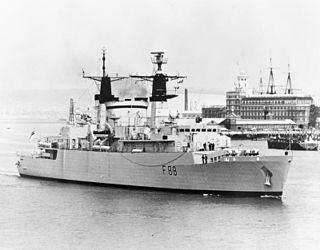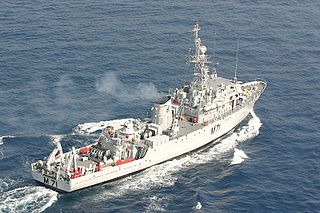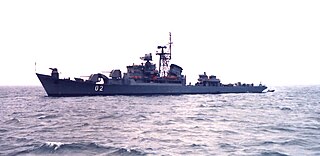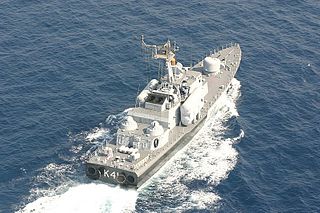The Ship/Submarine Recycling Program (SRP) is the process that the United States Navy uses to dispose of decommissioned nuclear vessels. SRP takes place only at the Puget Sound Naval Shipyard (PSNS) in Bremerton, Washington, but the preparations can begin elsewhere.
Ship commissioning is the act or ceremony of placing a ship in active service and may be regarded as a particular application of the general concepts and practices of project commissioning. The term is most commonly applied to placing a warship in active duty with its country's military forces. The ceremonies involved are often rooted in centuries-old naval tradition.

The Kirov class, Soviet designation Project 1144 Orlan, is a class of nuclear-powered guided missile cruisers of the Soviet Navy and Russian Navy, the largest and heaviest surface combatant warships in operation in the world. Among modern warships, they are second in size only to large aircraft carriers, and of similar size to a World War I-era battleship. The ships are often referred to as battlecruisers by Western defence commentators due to their size and general appearance. The Soviet classification of the ship-type is "heavy nuclear-powered guided missile cruiser".

A corvette is a small warship. It is traditionally the smallest class of vessel considered to be a proper warship. The warship class above the corvette is that of the frigate, while the class below was historically that of the sloop-of-war. The modern types of ships below a corvette are coastal patrol craft, missile boat and fast attack craft. In modern terms, a corvette is typically between 500 tons and 2,000 tons, although recent designs may approach 3,000 tons, which might instead be considered a small frigate.

USS Enterprise (CVN-65), formerly CVA(N)-65, is a decommissioned United States Navy aircraft carrier. She was the first nuclear-powered aircraft carrier and the eighth United States naval vessel to bear the name. Like her predecessor of World War II fame, she is nicknamed "Big E". At 1,123 feet (342 m), she is the longest naval vessel ever built. Her 93,284-long-ton (94,781 t) displacement ranks her as the 12th-heaviest carrier, after the ten carriers of the Nimitz class and USS Gerald R. Ford. Enterprise had a crew of some 4,600 service members.

HMS Ark Royal was a light aircraft carrier and former flagship of the Royal Navy. She was the third and final vessel of Invincible class. She was built by Swan Hunter on the River Tyne and launched by them in 1981. Ark Royal was christened by Queen Elizabeth The Queen Mother. She followed sister ships HMS Invincible and HMS Illustrious into service in 1985.

USS Louisville (SSN-724), a Los Angeles-class submarine, is the fourth ship of the United States Navy to be named for Louisville, Kentucky. The contract to build her was awarded to the Electric Boat Division of General Dynamics Corporation in Groton, Connecticut, on 11 February 1982 and her keel was laid on 24 September 1984. She was launched on 14 December 1985—sponsored by Mrs. Betty Ann McKee, wife of Admiral Kinnaird McKee, Director of Naval Nuclear Propulsion —and commissioned on 8 November 1986 with Captain Charles E. Ellis in command.

HMS Broadsword was the lead ship and first Batch 1 unit of the Type 22 frigates of the Royal Navy.

The Ticonderoga class of guided-missile cruisers is a class of warships in the United States Navy, first ordered and authorized in the 1978 fiscal year. The class uses passive phased-array radar and was originally planned as a class of destroyers. However, the increased combat capability offered by the Aegis Combat System and the AN/SPY-1 radar system, together with the capability of operating as a flagship, were used to justify the change of the classification from DDG to CG shortly before the keels were laid down for Ticonderoga and Yorktown.

The Belgian Navy, officially the Belgian Naval Component of the Belgian Armed Forces, is the naval service of Belgium.
The Nilgiri-class frigates were updated versions of the Leander class, designed and built for the Indian Navy by Mazagon Dock Limited in Mumbai. Six ships were built between 1972–81. Vessels of the class formed the 14th Frigate Squadron. The lead ship INS Nilgiri was the first major warship to be built in India and was built in collaboration with Yarrow Shipbuilders of the United Kingdom.

The Pondicherry class are a class of minesweepers built for the Indian Navy by the Soviet Union. They are modified versions of the Natya-class minesweeper. The vessels were acquired in two batches. The first were purchased from 1977 to 1980 and the second from 1986 to 1988. Technically, the second batch is referred to as the Karwar class but are physically identical to the first batch with the exception of additional surface-to-air missiles. As minesweepers, they are large and heavily armed. They can serve a dual purpose as an anti-submarine warfare escort. Their hulls are constructed of U3 low magnetic signature steel.

The Riga class was the NATO reporting name for class of frigates built for the Soviet Navy in the 1950s. The Soviet designation for these ships was Storozhevoi KorablProject 50 Gornostay. The Riga class was analogous to World War II era destroyer escorts.

The Pauk class is the NATO reporting name for a class of small patrol corvettes built for the Soviet Navy and export customers between 1977 and 1989. The Russian designation is Project 1241.2 Molniya-2. These ships are designed for coastal patrol and inshore anti-submarine warfare. The design is the patrol version of the Tarantul class which is designated Project 1241.1, but is slightly longer and has diesel engines. The ships are fitted with a dipping sonar which is also used in Soviet helicopters.

The TS Golden Bear is the training ship of the California State University Maritime Academy (CSUMA), a campus of the California State University. The first training ship of the then–California Nautical School was known as the Training Ship California State, then as the T.S. Golden State. Since then, there have been three ships to bear the name T.S. Golden Bear.

INS Khukri was the lead vessel of her class of corvettes, in service with the Indian Navy. The ship was named after INS Khukri, the only Indian Navy ship to be ever lost in combat.

The Veer-class corvettes of the Indian Navy are a customised Indian variant of the Soviet Tarantul class. They form the 22nd Killer Missile Vessel Squadron.













